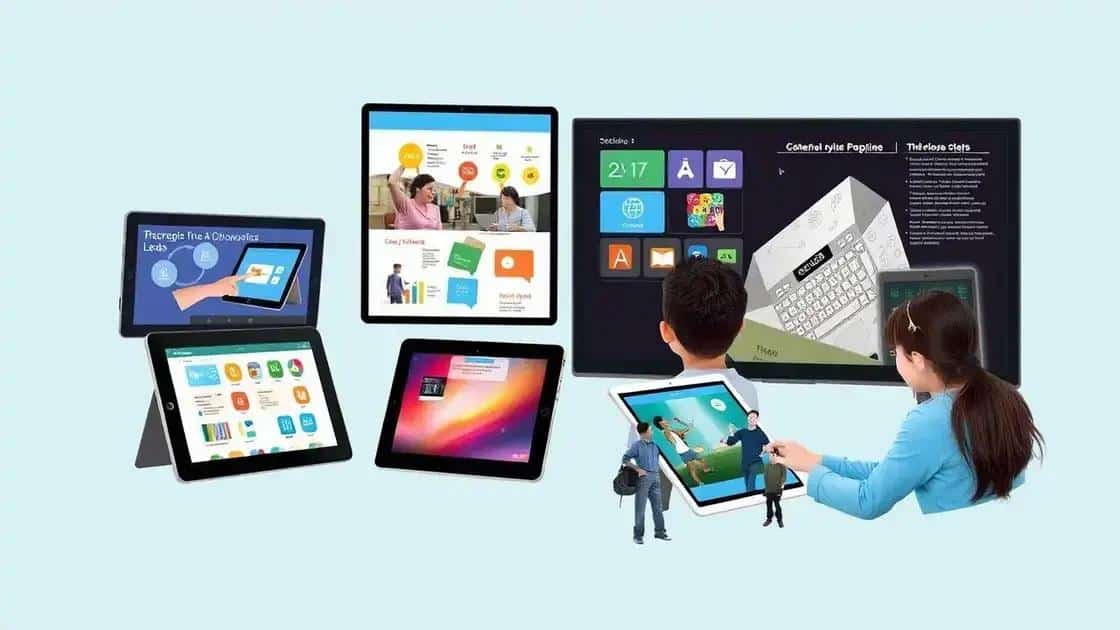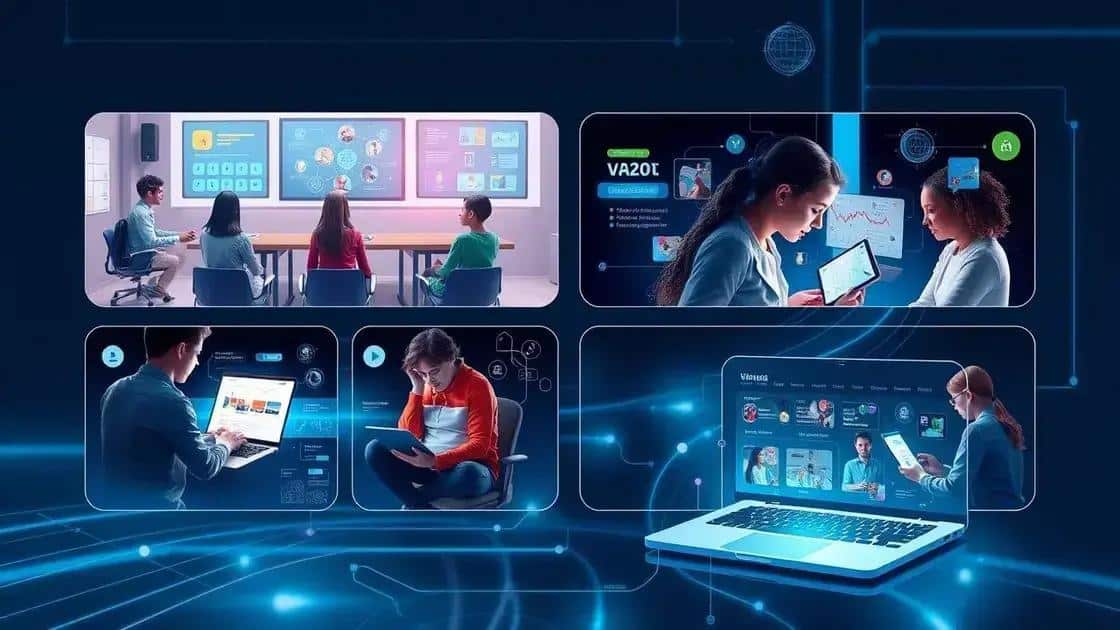Insights on edtech investment trends shaping the future

Insights on edtech investment trends highlight the growth of personalized learning, remote education technologies, and the integration of mental health support, shaping the future of education innovation.
Insights on edtech investment trends are essential for understanding the landscape of educational technology. With the rapid evolution of learning methods and tools, have you ever wondered what the future holds for these investments?
Current trends in edtech investments
The world of education technology is evolving quickly, and it’s vital to understand the current trends in edtech investments. Investors are keenly interested in innovations that enhance learning experiences. This surge reflects the growing demand for digital solutions in education.
Shifts towards Personalized Learning
One of the most significant trends is the shift towards personalized learning. This approach tailors education to individual student needs. Companies are developing platforms that use data analytics to adapt content for each learner.
Increased Focus on Edtech Accessibility
Accessibility in education is another critical trend. As more students engage with technology, it’s essential to ensure that these tools are available to everyone. Investors are looking at companies that create products designed for diverse learning styles and abilities.
- Tools for remote learning
- Adaptive learning technology
- Multilingual support features
- Assistive technologies for disabilities
Moreover, the increase in remote learning due to recent global events has highlighted the necessity for reliable platforms. As schools transition to hybrid models, long-term investment in this area becomes crucial.
Investment in AI and Machine Learning
Artificial intelligence and machine learning are becoming pillars of the edtech landscape. These technologies can analyze vast amounts of data and provide insights that help improve learning outcomes. With AI-powered tools, educators can personalize instruction and monitor student progress effectively.
Collaborations with Traditional Institutions
Furthermore, collaborations between edtech startups and traditional educational institutions are increasing. These partnerships enable schools to integrate cutting-edge technology into their curricula. Investing in companies that foster these collaborations can lead to fruitful returns.
The future of edtech investments looks promising as the landscape continues to change. This evolution indicates that savvy investors will prioritize companies that embrace innovation, accessibility, and collaboration.
Key factors driving investment decisions

Understanding the key factors driving investment decisions in edtech is crucial for both investors and entrepreneurs. Several elements influence where funding flows in this dynamic sector, and recognizing these can help target initiatives effectively.
Market Demand for Innovative Solutions
One major factor is the increasing market demand for innovative educational solutions. Schools and institutions are seeking technologies that improve learning outcomes and enhance engagement. This growing need compels investors to focus on startups providing effective learning tools.
Technological Advancements
Technological advancements also play a significant role. Innovations in artificial intelligence, virtual reality, and adaptive learning technologies catch investors’ eyes. These technologies promise to transform how students learn and retain information, making them attractive for funding.
- Integration of AI in edtech tools
- Growth of virtual and augmented reality platforms
- Development of data analytics for personalized learning
- Emerging mobile learning applications
Furthermore, regulatory factors can impact investment decisions. As governments establish new policies regarding education and technology, companies that align with these regulations can stand out. Investors tend to favor startups that can navigate these frameworks effectively.
Partnerships and Collaborations
Partnerships and collaborations between edtech companies and educational institutions significantly influence funding decisions. When startups establish strong ties with schools, they demonstrate their solutions’ real-world applicability, boosting investor confidence.
Another driving factor is the proven effectiveness of educational technologies. Investors are increasingly interested in products backed by research and data showing improved learning outcomes. Companies that can showcase successful case studies and measurable results are more likely to secure funding.
As the edtech landscape continues to evolve, understanding these key factors driving investment decisions becomes essential. By staying informed, both investors and entrepreneurs can align their strategies with market needs and trends.
Emerging technologies in education
Emerging technologies in education are reshaping the way we approach teaching and learning. As classrooms evolve, understanding these innovations becomes essential for educators and investors alike. Among these technologies, the rise of artificial intelligence is particularly striking. AI can personalize learning experiences, adjust content based on student performance, and even automate administrative tasks.
Virtual and Augmented Reality
Another groundbreaking development is the use of virtual reality (VR) and augmented reality (AR) in education. These technologies create immersive learning environments, allowing students to explore complex concepts in a hands-on manner. For instance, VR can transport students to historical sites or scientific environments, enhancing engagement and understanding.
- Interactive simulations for science education
- VR field trips to global landmarks
- AR experiences that blend real-world elements with digital content
Additionally, gamification is becoming a popular strategy to improve learning outcomes. By incorporating game design elements into educational content, teachers can motivate students to participate and excel. This approach makes learning more enjoyable while still emphasizing important lessons.
Data Analytics in Education
Data analytics also plays a vital role in the future of education. By leveraging big data, educators can identify trends in student performance, allowing them to tailor instruction to meet individual needs. This analysis helps in making data-driven decisions to improve both teaching methods and learning experiences.
Moreover, the increasing use of mobile learning expands access to education. With smartphones and tablets, students can learn anytime and anywhere. This flexibility is particularly beneficial for those with busy schedules, enabling continuous education beyond traditional classroom settings.
As these emerging technologies continue to advance, they open new doors for innovation in education. Educators and learners must stay updated on these trends to fully leverage their potential in enhancing the learning process.
Future predictions for edtech investments

Future predictions for edtech investments reveal exciting possibilities for the education landscape. As technology continues to evolve, investors are keen on finding innovative solutions that can reshape how we learn. The integration of advanced analytics and practical applications of artificial intelligence will likely lead the way in the upcoming years. These tools can help tailor educational experiences to fit the needs of individual students.
Growth in Personalized Learning
One prominent trend in the future of edtech is the growth of personalized learning solutions. As schools increasingly focus on meeting the unique needs of each student, platforms that offer customized learning experiences will attract attention. These platforms may utilize data to adapt learning materials to fit a student’s pace and preferences.
Increased Investment in Remote Learning
Furthermore, remote learning technologies are expected to see substantial investment. The shift to online learning during recent global events highlighted the flexibility and accessibility that these solutions provide. Companies that enhance the virtual classroom experience are likely to draw significant funding.
- Interactive tools for online collaboration
- Enhanced multimedia content delivery
- Robust learning management systems
Moreover, the emphasis on mental health and well-being will be pivotal. Edtech solutions that support students’ emotional health alongside academic success will become increasingly vital. Investors may focus on startups that blend mental health resources with educational technology.
Focus on Lifelong Learning
As e-learning becomes a norm, there will be a shift toward lifelong learning. Adults seeking to upskill or reskill will drive demand for flexible learning platforms. Predictions suggest that edtech companies providing tailored courses for various industries will gain traction among investors.
In addition, as global connectivity continues to improve, edtech investments will likely expand into emerging markets. Regions with growing digital infrastructure are ripe for innovative education solutions. As opportunities multiply, savvy investors should keep an eye on startups entering these markets.
In summary, the future of edtech investments promises to be dynamic and growth-oriented. By understanding these trends, both investors and educational institutions can make informed decisions that will shape the landscape of learning.
FAQ – Frequently Asked Questions about Edtech Investments
What are the main trends in edtech investments right now?
Current trends include personalized learning platforms, remote education technologies, and tools focusing on mental health.
How does artificial intelligence affect education?
AI personalizes learning experiences, improves administrative tasks, and provides valuable insights into student performance.
Why is mental health a focus in edtech investments?
Mental health support is essential for student success, and solutions that address this need attract significant attention from investors.
What future opportunities exist for lifelong learning in edtech?
With the rise of online learning, opportunities for adults to upskill or reskill will drive demand for flexible educational platforms.





